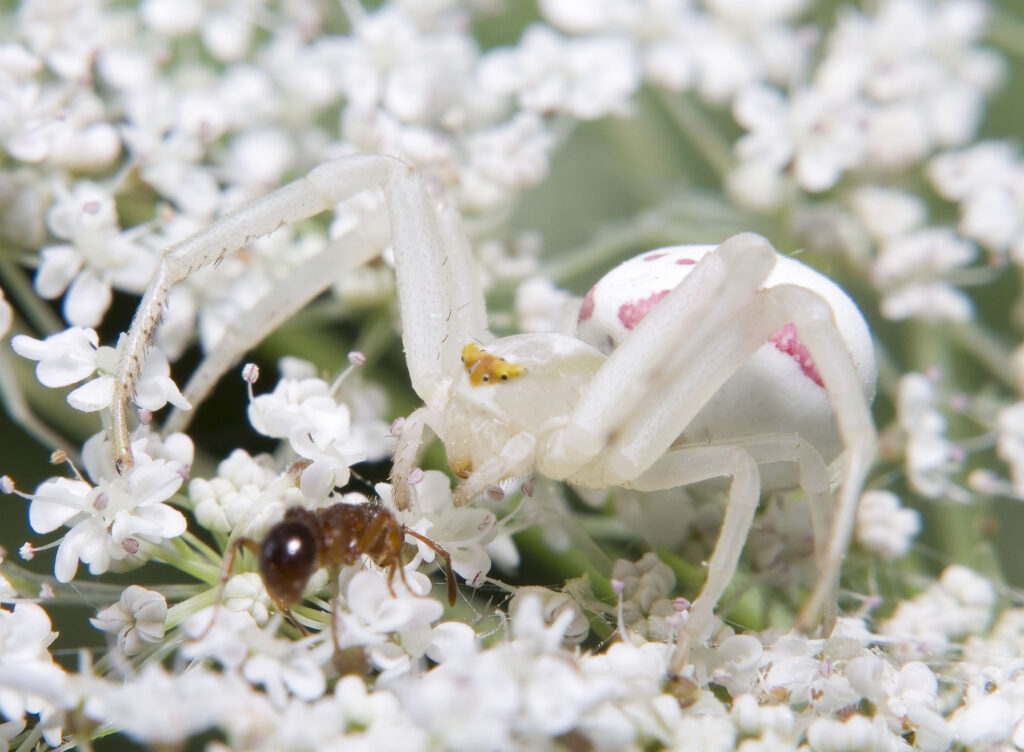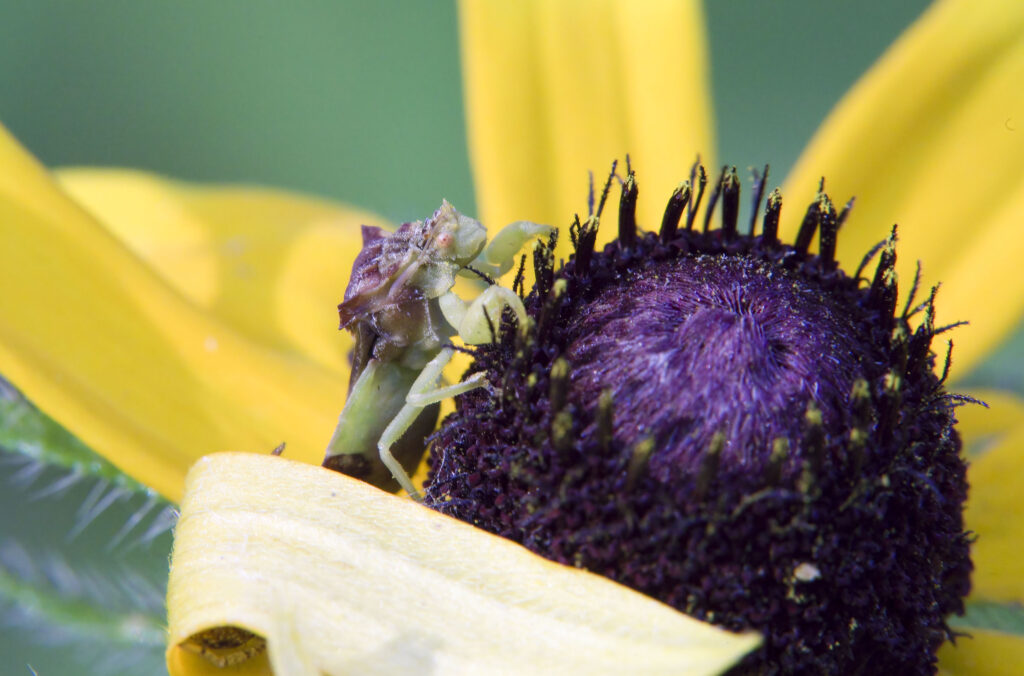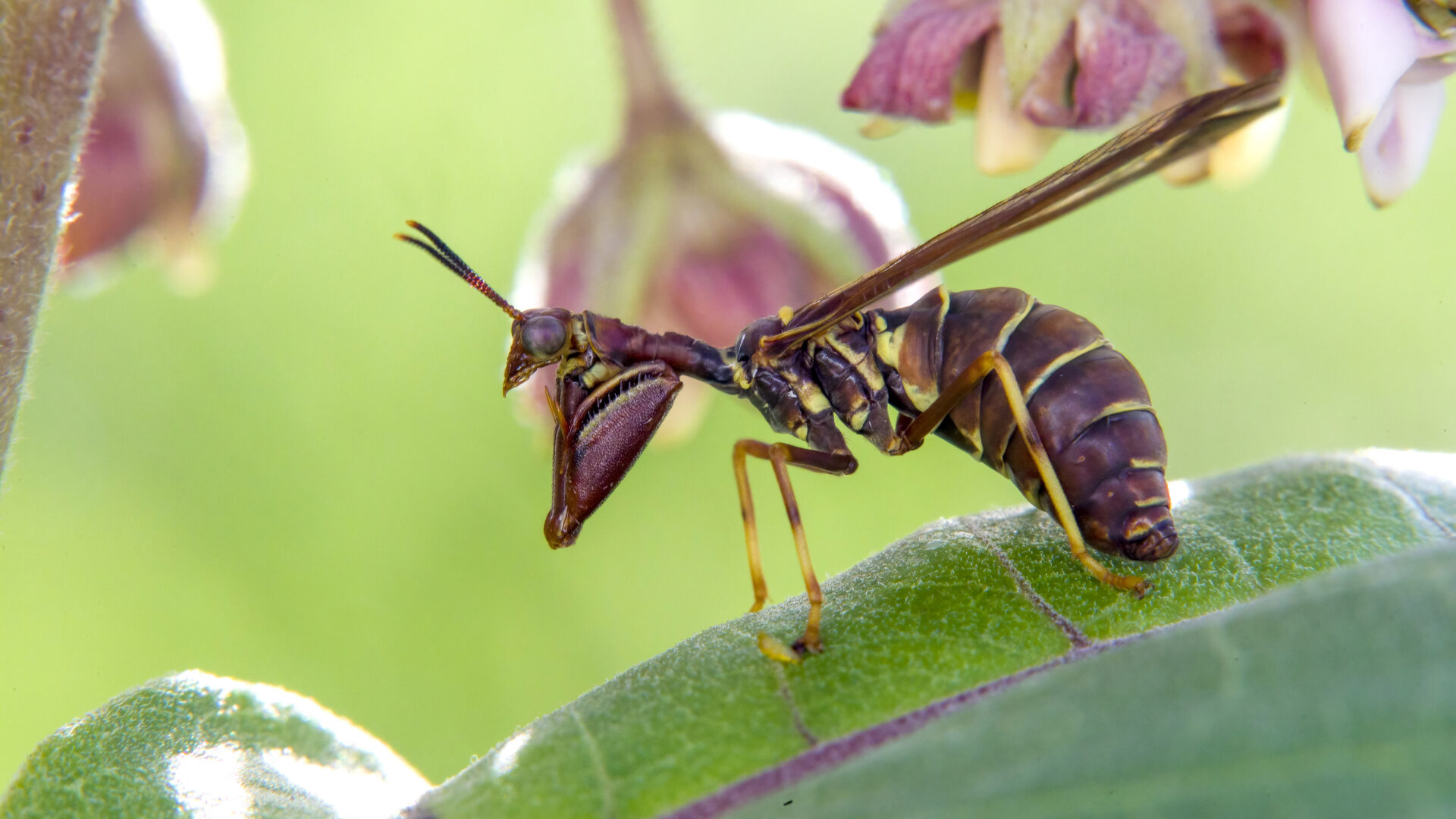Blooming wildflowers provide a rich hunting ground for many animals, and as summer progresses different hunters prowl the flowers looking for a meal.
One of these most interesting hunters is the brown wasp mantidfly, Climaciella brunnea. Combining the features of a praying mantis and a paper wasp, one might think these insects emerged from a mad entomologist’s lab. In fact, they are members of the order Neuroptera, which also includes the gardener’s friend, the green lacewing.
Brown wasp mantidflies are most often seen in early summer. A good place to look for them is among milkweed blossoms. If you spot a wasp on one of these plants, take another look – it could be a mantidfly! In an excellent example of Batesian mimicry, the mantidfly has evolved a large abdomen, tiny waist and a brown body with yellow striping that closely resembles the dark paper wasp, Polistes fuscatus. This mimicry provides the mantidfly with some protection from predators which would rather avoid a potentially dangerous stinging wasp.
Mantidflies lurk in flower blossoms or under leaves, waiting for prey to draw near. They eat flies and other small insects which they capture in their raptorial forelegs, like a praying mantis. They may also feed on nectar and are frequently observed sipping from milkweed flowers if other prey is scarce.
This mantidfly has an interesting life cycle; the adult lays eggs on the underside of leaves, and once they hatch, the larvae search for a spider to hitch a ride on. If it’s male, they wait for it to encounter a female, and then they transfer to her. When a female spins an egg sac, the larvae hide inside and feed on the eggs. After metamorphosis, the adults emerge and continue the cycle.
The mantidfly usually seeks a ground-dwelling wolf spider for a host, which is of benefit for another hunter in the flowers, the goldenrod crab spider, Misumena vatia. This spider lays her eggs in a folded leaf, well above any chance encounters with ground-dwelling mantidfly larvae. Once the spiderlings hatch, they disperse and find new hunting grounds.

It is on these hunting grounds that the goldenrod crab spiders display their own special skill – they’re able to change colour. Hatchlings emerge white, but if females settle on a yellow flower, they produce a yellow pigment which will change their colour to match the flower. Some goldenrod crab spiders have striking magenta markings on their abdomens, which persist if the spider changes colour.
These spiders are common in Niagara, but this camouflage makes them difficult to find, even for a trained eye. Often, the best indication that a goldenrod crab spider is lurking on a flower is that the spider is still holding a meal. Able to subdue prey much larger than themselves, these spiders often feed on hairstreak butterflies, skippers (which are related to butterflies and moths, and share many features of both), and bees.
When hunting, these spiders usually wait with their front two legs spread apart, ready to quickly close on prey. They then deliver a venomous bite to subdue their food. As with most spiders in Ontario, this venom is only dangerous to insects and other small animals; these spiders are harmless to humans.
As their name implies, goldenrod crab spiders are often found in goldenrod later in summer. Other frequent hunting grounds for white-form spiders include fleabane, daisies, and yarrow; yellow spiders can often be found lurking on the petals of black-eyed Susans, elecampane and sunflowers.
Another well-camouflaged hunter that can be found on flowers late into summer and early fall is the jagged ambush bug (genus Phymata). These true bugs have brown bodies with chartreuse green or yellow legs, heads, and abdominal banding. This colour pattern helps these hunters camouflage themselves in Queen Anne’s lace, goldenrod, and similar composite flowers.

While not closely related to the brown wasp mantidfly or the praying mantis, the jagged ambush bug also has raptorial forelegs that grasp potential prey. The bug’s piercing mouthparts then inject a venom that paralyzes their prey and starts the digestive process.
As with the goldenrod crab spider, the jagged ambush bug is able to take on prey many times its size. They frequently feed on bumblebees, butterflies and moths. When food is scarce, like the brown wasp mantidfly, the jagged ambush bug can also drink nectar. However, studies have shown that juvenile ambush bugs are unable to molt without having an insect meal, so they need at least one successful hunt before becoming adults.
All three of these fascinating animals have evolved traits that help them avoid predators while remaining efficient hunters. Next time you’re out on a walk, be sure to check the blossoms for these tiny predators.
